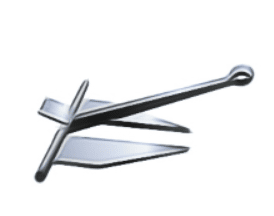Anchors
In emergency situations, anchors can be very helpful. If your engine fails and you are at risk of drifting into shallow waters or into the path of another vessel, dropping the anchor will keep you from drifting while you wait for assistance.
What makes a good anchor is design and weight. Your anchor selection should depend on the holding power needed (relative to size of the boat) and the type of waterway bottom (i.e. mud, sand, rock etc.)
Having the right anchor and cable for your boat is important. If you do not, rough winds and water can cause it to drag, leaving your boat to drift. This is especially dangerous if you are asleep or swimming nearby. Make sure your boat is well anchored and keep watch to detect signs of dragging.
When carrying an anchor on board a pleasure craft, the minimum length of anchor rode (rode is the combined length of chain and rope attached to the anchor) required depends on the length of the boat. Make sure the anchor is always accessible and the rode is free of entanglements.
There are a number of different types of anchors:

Danforth or Fluke Anchor: has pivoting flukes that bury the anchor. Best for soft mud and grass.

Plow Anchor: is popular with cruising sailors and other private boaters. Generally good for all bottoms.

Mushroom Anchor: is suitable where the seabed is flat and composed of silt or fine sand.

